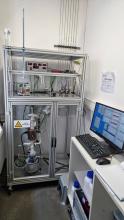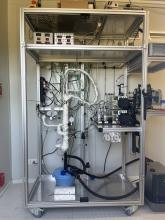Our work on sustainable fuels explores the use of CO2 (or CO) as a raw material for gaseous and liquid energy sources. The greenhouse gas CO2 can be obtained either from biomass or from unavoidable point sources (e.g. cement and glass works, chemical industry, waste incineration). This makes it possible to recycle the CO2 and thus limit CO2 emissions. This means that when the synthetic fuel is later burned to "generate" electricity and heat as well as for mobility, only the amount of CO2 that was previously used in the production of the fuel is released. In this context, we examine the following process routes, which are described in more detail below:
- CO2 conversion to synthetic natural gas
- CO2 hydrogenation to methanol
- Conversion of methanol to gasoline
- Oligomerization of methanol-derived olefins
- Fischer-Tropsch synthesis
CO2 hydrogenation to methane:
In the field of CO2 methanation, our working group is pursuing the so-called power-to-gas concept (PtG). This involves converting CO2, which is produced in biogas plants or from so-called point sources (e.g. glass smelters, cement works), into synthetic natural gas (methane): CO2 + 4 H2 ↔ CH4 + 2 H2O. The hydrogen required for CO2 hydrogenation is to be produced by electrolysis of water using electricity generated from renewable sources (wind power, photovoltaics). This enables both the reduction of CO2 emissions and the storage of energy from the fluctuating sources of wind and sun. The methane produced is then fed into the natural gas grid and thus made available for energy use, for example in households or gas engines (e.g. motor vehicles and combined heat and power plants).
The central element of the power-to-gas concept is the hydrogenation catalyst, in which the CO2 is converted to CH4. However, the nickel catalysts used in technology to date are toxicologically questionable and tend to form volatile carbonyls which are also very toxic. For this reason, our working group is focusing on the targeted development of new types of catalysts that are toxicologically safe and also cost-effective. The focus here is primarily on iron-containing catalyst materials, but also on other active components.
CO2 hydrogenation to methanol:
Similar to methanation, our research work in the field of CO2 hydrogenation to methanol (CO2 + 3 H2 = CH3OH + H2O) is concerned with the combined reduction of CO2 and the storage of "green" electricity. The aim is to produce methanol as a chemical energy storage medium and chemical raw material. The main challenge is the development of a dynamic methanol synthesis from CO2 and H2 produced by water electrolysis, as the synthesis must be adapted to the partially fluctuating input of the two reaction partners. In this context, our working group is investigating the activity and long-term stability of the Cu/ZnO/Al2O3 catalysts used in technology under dynamic process conditions and developing concepts for improved dynamic catalysts. Large-scale methanol synthesis, on the other hand, takes place exclusively under stationary conditions. A further concern is research into new types of iron catalysts for methanol synthesis.
Methanol to Gasoline:
The methanol-to-gasoline (MtG) process is one of the final links in the process chain for the production of climate-neutral gasoline. Using renewable energies and water, methanol is first produced from CO2, which is converted into hydrocarbons by a zeolite catalyst in the MtG process. The chemical composition of the reaction products is very similar to fossil gasoline. The aim of our research is to tailor the properties of the resulting petrol by specifically adapting the process and catalyst properties to the quality requirements. This makes it possible to further develop catalysts that can be used to produce climate-neutral fuels for the mobility sector.
Fischer-Tropsch synthesis based on CO and CO2:
Fischer-Tropsch synthesis was developed back in the 1920s and is used to produce fuels and chemical raw materials from CO and H2 (n CO + (2n+1) H2 = CnH2n+2 + n H2O). In recent years, the use of CO2 for Fischer-Tropsch synthesis has also been increasingly investigated. In this context, our group is working on the utilization of CO2 from biogases, especially for the synthesis of gasoline, kerosene, diesel fuel and waxes. Novel toxicologically safe and cost-effective iron catalysts are being developed as an alternative to commercially available cobalt-based catalysts.
Oligomerization of lower olefins:
The oligomerization of lower olefins such as propene and butene goes back to the Mobil Oil Company's MOGD process, which was developed in the 1980s. Fuel components were produced from methanol-derived olefins. The conversion of short-chain olefins into gasoline and diesel components is also known from the COD process (PetroSA). There, the olefins are produced as by-products of the Fischer-Tropsch synthesis. Our concept initially pursues the production of the lower olefins in the MTO process (Methanol to Olefins), whereby "green" methanol is used. During the subsequent oligomerization, which is catalyzed on solid catalysts with acidic active centers, the desired longer-chain products are formed, which can be classified as sustainable and thus stand out from the corresponding fossil substances. The target products are liquid fuels such as kerosene, gasoline, diesel and heating oil, as well as chemical raw materials (e.g. for lubricants and detergents). The resulting oligomers are olefins and must therefore be hydrogenated in a final step and, if necessary, fractionated by distillation. The subject of research in oligomerization is catalyst development, mechanism elucidation, process control and product characterization.




